

Demon. In Ancient Near Eastern religions as well as in the Abrahamic traditions, including ancient and medieval Christian demonology, a demon is considered an unclean spirit, sometimes a fallen angel, the spirit of a deceased human, or a spirit of unknown type which may cause demonic possession, calling for an exorcism.

In Western occultism and Renaissance magic, which grew out of an amalgamation of Greco-Roman magic, Jewish demonology and Christian tradition,[2] a demon is a spiritual entity that may be conjured and controlled. Terminology[edit] The Greek term does not have any connotations of evil or malevolence. In fact, εὐδαιμονία eudaimonia, (literally good-spiritedness) means happiness. The supposed existence of demons remains an important concept in many modern religions and occultist traditions. Psychological archetype[edit] M. By tradition[edit] Ancient Near East[edit] Mesopotamia[edit] Human-headed winged bull, otherwise known as a Lamassu Ancient Arabia[edit] Hebrew Bible[edit] List of theological demons. A demon This is a list of demons that appear in religion, theology, demonology, mythology, and folklore.
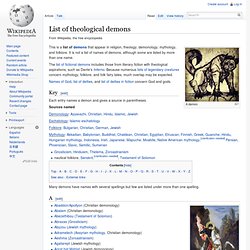
It is not a list of names of demons, although some are listed by more than one name. Archdemon. In Biblical tradition, an archdemon (also spelled archdaemon) is a spiritual entity, prominent in the infernal hierarchy as a leader of the infernal host.[1] Essentially, the archdemons is the counterpart of the archangels.
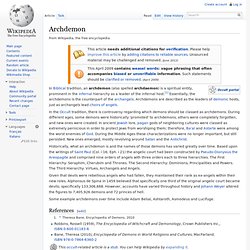
Archdemons are described as the leaders of demonic hosts, just as archangels lead choirs of angels. In the Occult tradition, there is controversy regarding which demons should be classed as archdemons. During different ages, some demons were historically 'promoted' to archdemons, others were completely forgotten, and new ones were created. In ancient Jewish lore, pagan gods of neighboring cultures were classed as extremely pernicious in order to protect Jews from worshiping them; therefore, Ba'al and Astarte were among the worst enemies of God.
During the Middle Ages these characterizations were no longer important, but still persisted. Satan. Satan (Hebrew: שָּׂטָן satan, "adversary,"[1]) is a term, later a character appearing in the texts of the Abrahamic religions[2][3] who personifies evil and temptation, and is known as the deceiver that leads humanity astray.
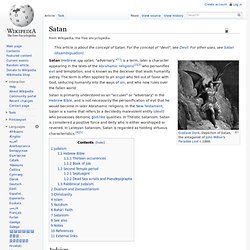
The term is often applied to an angel who fell out of favor with God, seducing humanity into the ways of sin, and who now rules over the fallen world. Satan is primarily understood as an "accuser" or "adversary" in the Hebrew Bible, and is not necessarily the personification of evil that he would become in later Abrahamic religions. In the New Testament, Satan is a name that refers to a decidedly malevolent entity (devil) who possesses demonic god-like qualities. In Theistic Satanism, Satan is considered a positive force and deity who is either worshipped or revered. In LaVeyan Satanism, Satan is regarded as holding virtuous characteristics.[4][5] Judaism Hebrew Bible Thirteen occurrences Job ch.1–2 (10x),[8]Zechariah 3:1–2 (3x).[9] Book of Job Second Temple period.
Aevum. The concept of the aevum dates back at least to Albertus Magnus’s treatise De quattuor coaequaevis.[3] Its most familiar description is found in the Summa theologica of Thomas Aquinas.
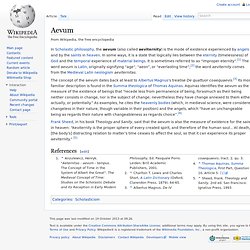
Angel. An angel (from the Greek ἄγγελος - ángelos[1]) is a supernatural being or spirit, often depicted in humanoid form with feathered wings on their backs and halos around their heads, found in various religions and mythologies.
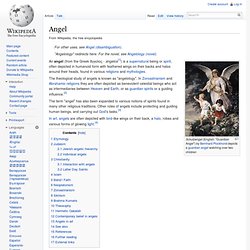
The theological study of angels is known as "angelology". In Zoroastrianism and Abrahamic religions they are often depicted as benevolent celestial beings who act as intermediaries between Heaven and Earth, or as guardian spirits or a guiding influence.[2] The term "angel" has also been expanded to various notions of spirits found in many other religious traditions. Other roles of angels include protecting and guiding human beings, and carrying out God's tasks.[3] Etymology[edit] The word angel in English is a fusion of the Old English/Germanic word engel (with a hard g) and the Old French angele. Archangel. An archangel /ˌɑrkˈeɪndʒəl/ is an angel of high rank.

Michael (archangel) Michael ("who is like God?
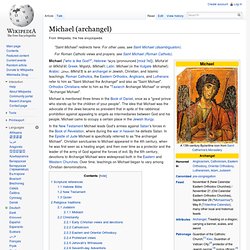
", Hebrew: מִיכָאֵל (pronounced [mixåˈʔel]), Micha'el or Mîkhā'ēl; Greek: Μιχαήλ, Mikhaḗl; Latin: Michael (in the Vulgate Michahel); Arabic: ميخائيل, Mīkhā'īl) is an archangel in Jewish, Christian, and Islamic teachings. Roman Catholics, the Eastern Orthodox, Anglicans, and Lutherans refer to him as "Saint Michael the Archangel" and also as "Saint Michael". Orthodox Christians refer to him as the "Taxiarch Archangel Michael" or simply "Archangel Michael". Sandalphon. Sandalphon (Hebrew: סָנְדַלְפוֹן; Greek: Σανδαλφών) is an archangel in Jewish and Christian writings.
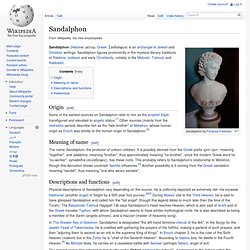
Sandalphon figures prominently in the mystical literary traditions of Rabbinic Judaism and early Christianity, notably in the Midrash, Talmud, and Kabbalah. Origin[edit] Uriel. Uriel (אוּרִיאֵל "El/God is my light", Auriel/Oriel (God is my light) Standard Hebrew Uriʾel, Tiberian Hebrew ʾÛrîʾēl) is one of the archangels of post-Exilic Rabbinic tradition, and also of certain Christian traditions.

In Judaism and Christianity[edit] Name and origins[edit] Gabriel. In Abrahamic religions, Gabriel (Hebrew: גַּבְרִיאֵל, Modern Gavri'el Tiberian Gaḇrîʼēl, God is my strength; Arabic: جبريل, Jibrīl or جبرائيل Jibrāʾīl) is an angel who typically serves as a messenger sent from God to certain people. Metatron. Origins[edit] The identification of Metatron with Enoch is not explicitly made in the Talmud although it does reference a Prince of the World who was young but now is old.
Raphael (archangel) Raphael (Standard Hebrew רָפָאֵל, Rāfāʾēl, "It is God who heals", "God Heals", "God, Please Heal") is an archangel of Judaism and Christianity, who in the Judeo-Christian tradition performs all manners of healing. In Islam, Raphael is the same as Israfil. Raphael is mentioned in the Book of Tobit, which is accepted as canonical by Catholics, Orthodox, and some Anglo-Catholics, and as useful for public teaching by Lutherans and Anglicans. Raphael is generally associated with the angel mentioned in the Gospel of John as stirring the water at the healing pool of Bethesda. The angels mentioned in the Torah, the older books of the Hebrew Bible, are without names. Rabbi Shimon ben Lakish of Tiberias (A.D. 230–270), asserted that all the specific names for the angels were brought back by the Jews from Babylon, and modern commentators would tend to agree. Maalik. In Islamic belief, Maalik (Arabic: مالك / mālik) denotes an angel in Hell (Arabic: جهنم / jahannam) who guards the Hellfire, assisted by 19 mysterious guardians known as الزبانية / az-zabānīya.
In the Qur'an, Maalik is mentioned in Sura 43:77, telling the wicked who appeal to him that they must remain in Hell because "they abhorred the truth when the truth was brought to them. " List of theological angels. Paradiso Canto 31 This is a list of angels in theology, including both specific angels (e.g. Gabriel) and types of angels (e.g. Seraphim). Note that some overlap is to be expected with the list of theological demons entry, since various traditions have different classifications for the spirits they mention.
Four Horsemen of the Apocalypse. Nikolaos. The name "Nicolaitans" is derived from the Greek word nikόlaos, a compound of the words nikos and laos. The word nikos is the Greek word that means to conquer or to subdue as already mentioned above. Samael. Tpolemos. Limos. Watcher (angel) The Grigori. The Grigori - Angelic Watchers.